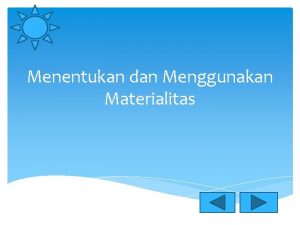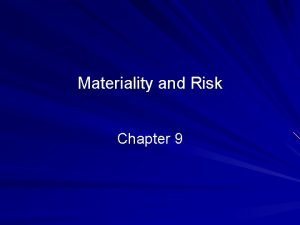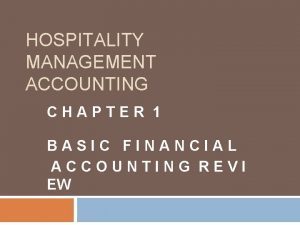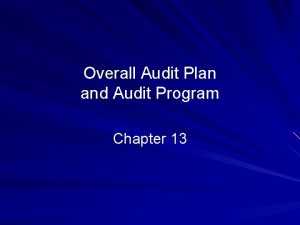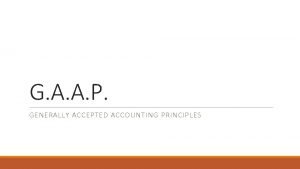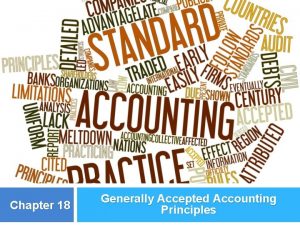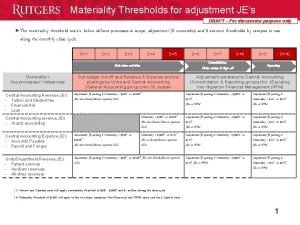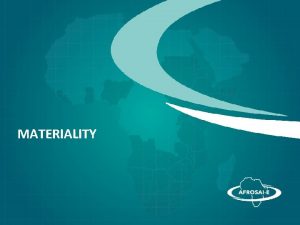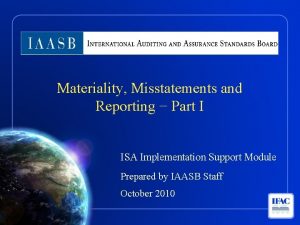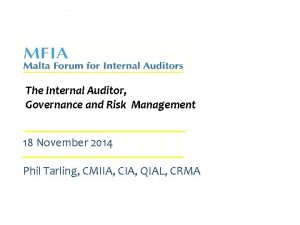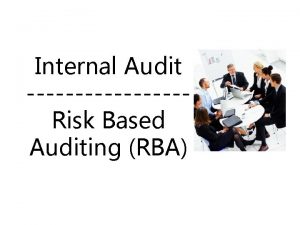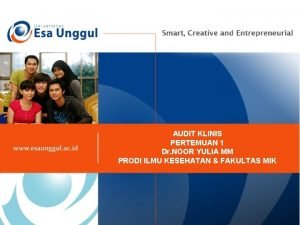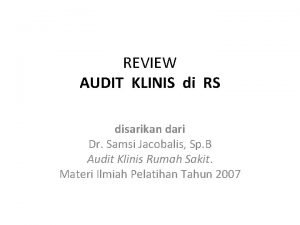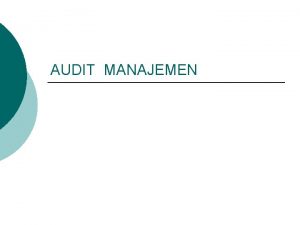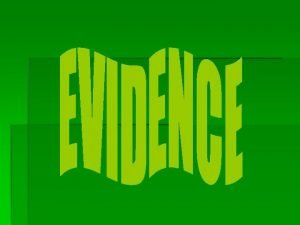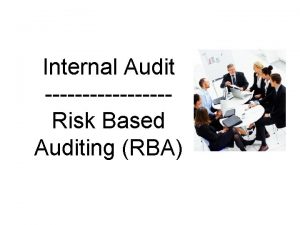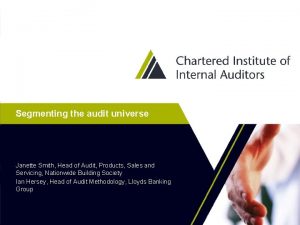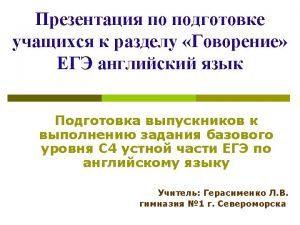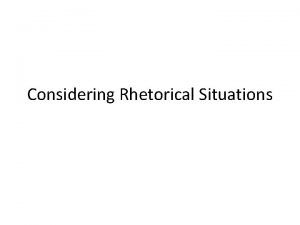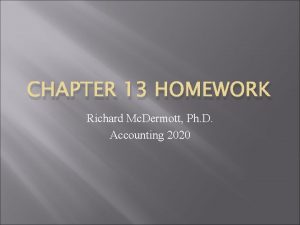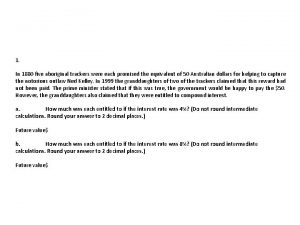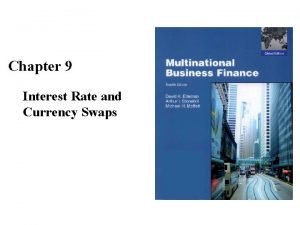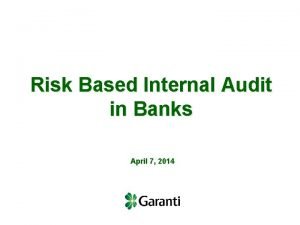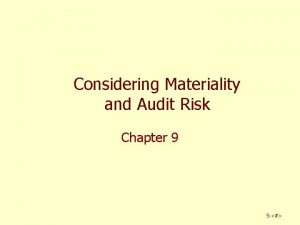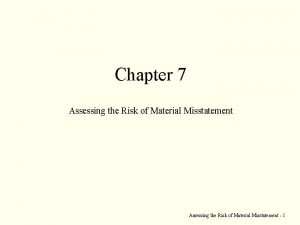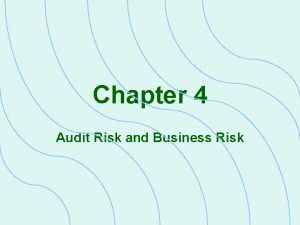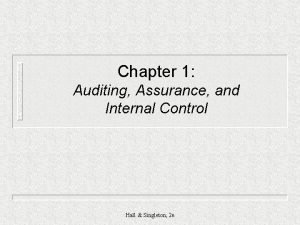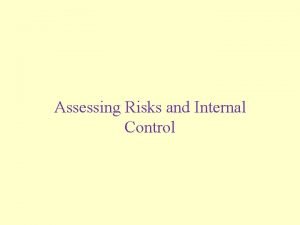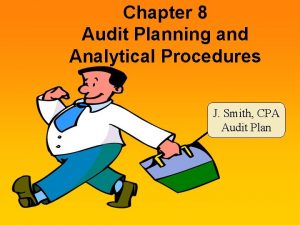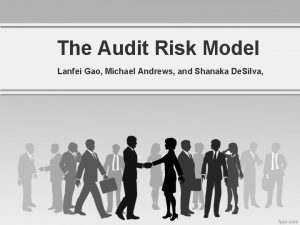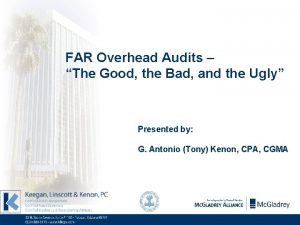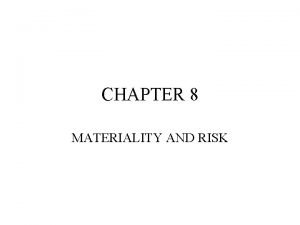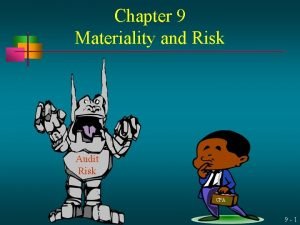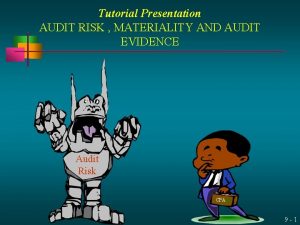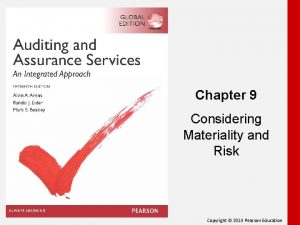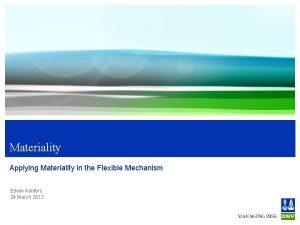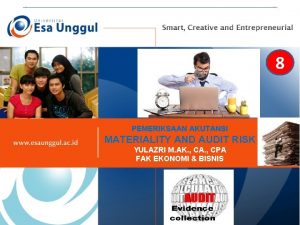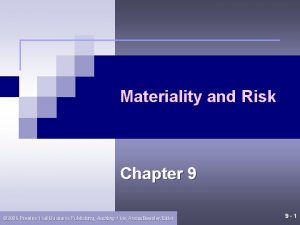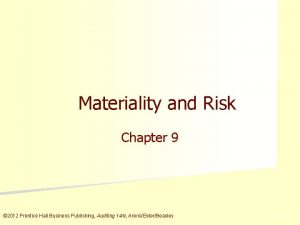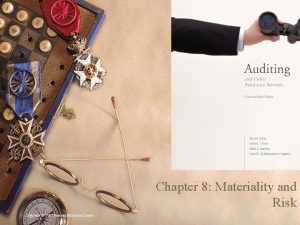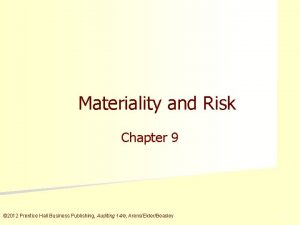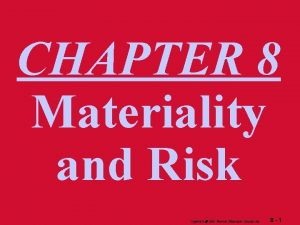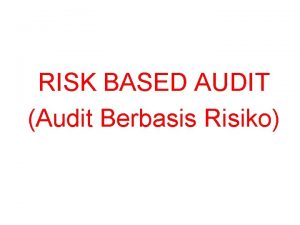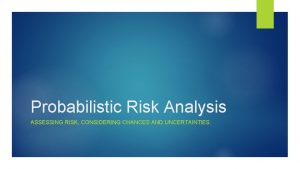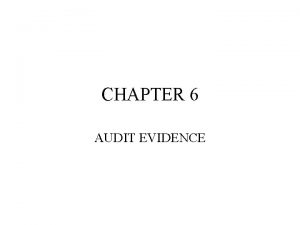Considering Materiality and Audit Risk Chapter 9 5













































- Slides: 45

Considering Materiality and Audit Risk Chapter 9 5 -<#>

Learning Objective 1 Apply the concept of materiality to the audit. 2

Materiality ØMajor consideration in determining the appropriate audit report ØReferenced in audit report’s scope paragraph ØWhat is meant by the term “material”? 3

Materiality Auditor’s responsibility = determine whether financial statements are materially misstated. Auditor will bring material misstatements to the client’s attention so corrections can be made. 4

Steps in Applying Materiality 5

Learning Objective 2 Make a preliminary judgment about what amounts to consider material. 6

Set Preliminary Judgment About Materiality Auditors set materiality thresholds early in the engagement. Thresholds represent the maximum statements that could be misstated and still not affect users decisions. 7

Factors Affecting Judgment Materiality is a relative rather than an absolute concept. Bases are needed for evaluating materiality. Qualitative factors also affect materiality. 8

Qualitative Factors Considerations that may render material a quantitatively small misstatement include: Loan covenants Changing trend Management compensation Financial statements users Conceals an illegal act 9

Guidelines Accounting and auditing standards do not provide specific materiality guidelines. Professional judgment is used to set and apply materiality guidelines. 10

Learning Objective 3 Allocate preliminary materiality to segments of the audit during planning. 11

Allocate Preliminary Judgment About Materiality to Segments Evidence is accumulated by segments rather than for the financial statements as a whole. Most practitioners allocate materiality to balance sheet accounts. Ø SAS 107 (AU 312) 12

Learning Objective 4 Use materiality to evaluate audit findings. 13

Known and Likely Misstatements Auditor can determine the misstated amount in an account (“Known”) Two types of “Likely” misstatements: Ø Judgmental differences Ø Projections of misstatements from audit samples 14

Estimated Total Misstatement and Preliminary Judgment 15

Estimated Total Misstatement and Preliminary Judgment Estimated Net misstatements in Sample ($3, 500) × Total recorded = Misstatement Total sampled ($50, 000) population value ($31, 500) ($450, 000) 16

Learning Objective 5 Define risk in auditing. 17

Risk ØAuditors accept some level of risk in performing the audit. ØRisks exist, are difficult to measure, and require careful thought in response. ØProper risk response is critical to achieving a high-quality audit. 18

Risk and Evidence Auditors need to understand the client’s business and assess business risk. The audit risk model helps identify the potential and likelihood of misstatements. 19

Audit Risk Model for Planning PDR = AAR ÷ (IR × CR) where: PDR = Planned detection risk AAR = Acceptable audit risk IR = Inherent risk CR = Control risk 20

Audit Risk Model for Planning 21

Illustration of Differing Evidence Among Cycles Sales and collection cycle Acquisition Payroll and payment personnel cycle A Inherent risk Medium High Low B Control risk Medium Low C Acceptable audit risk Low Low D Planned Medium detection risk Medium High 22

Illustration of Differing Evidence Among Cycles Inventory and warehousing cycle Capital acquisition and repayment cycle A Inherent risk High Low B Control risk High Medium C Acceptable audit risk Low D Planned Low detection risk Medium 23

Learning Objective 6 Describe the audit risk model and its components. 24

Audit Risk Model Components Planned Detection Risk Inherent Risk Control Risk Acceptable Audit Risk 25

Learning Objective 7 Consider the impact of engagement risk on acceptable audit risk. 26

Engagement Risk What is Engagement Risk? 27

Impact of Engagement Risk on Acceptable Audit Risk Auditors decide engagement risk and use that risk to modify acceptable audit risk. Engagement risk closely relates to client business risk. 28

Factors Affecting Acceptable Audit Risk Ø The degree to which external users rely on the statements ØThe likelihood that a client will have financial difficulties after the audit report is issued ØThe auditor’s evaluation of management’s integrity 29

Methods Practitioners Use to Assess Acceptable Audit Risk 30

Learning Objective 8 Consider the impact of several factors on the assessment of inherent risk. 31

Factors Affecting Inherent Risk Nature of Client’s Business Ø Industry practices Ø Non-routine transactions Ø Makeup of the population Audit Experience Ø Prior audit results Ø Initial vs. repeat engagement Ø Audit judgment required to correctly record balances and transactions Culture Ø Related parties Ø Factors related to fraudulent financial reporting Ø Factors related to misappropriation of assets 32

Learning Objective 9 Discuss the relationship of risks to audit evidence. 33

Relationship of Factors Influencing Risks to Risks and Risks to Planned Evidence Acceptable audit risk D D Factors influencing risks Inherent risk I Planned detection risk I I I Planned audit evidence D Control risk D = Direct relationship; I = Inverse relationship 34

Relationship of Factors Influencing Risks to Risks and Risks to Planned Evidence ØAuditors can change the audit to respond to risks ØThe engagement may require more experienced staff ØThe engagement will be reviewed more carefully than usual 35

Audit Risk for Segments Both control risk and inherent risk are typically set for each cycle, each account, and often even each audit objective, not for the overall audit. 36

Tolerable Misstatement, Risks, and Balance-related Audit Objectives ØIt is common to assess inherent and control risk for each balance-related audit objective ØIt is not common to allocate materiality to objectives 37

Risk and Evidence 38

Measurement Limitations One major limitation in the audit risk model is the difficulty of measuring the components of the model. Known Unknown Preliminary Assessed Level of Risk Actual level of risk achieved on the audit +/- 39

Relationships of Risk to Evidence Acceptable Inherent audit risk Control risk Planned detection risk 1 High Low High 2 Low Low Medium 3 Low High Low 4 Medium Medium 5 High Situation Low Amount of evidence required Low High Medium 40

Tests of Details of Balances Evidence Planning Worksheet Auditors develop various types of worksheets to aid in relating the considerations affecting audit evidence to the appropriate evidence to accumulate. 41

Learning Objective 10 Discuss how materiality and risk are related and integrated into the audit process. 42

Relationship of Tolerable Misstatement and Risks to Planned Evidence Acceptable audit risk Inherent risk Control risk D I Planned detection risk I D I I Planned audit evidence D I Tolerable misstatement D = Direct relationship; I = Inverse relationship 43

Revising Risks and Evidence The auditor must revise the original assessment of the appropriate risk. The auditor should consider the effect of the revision on evidence requirements, without the use of the audit risk model. 44

End of Chapter 9 45
 Overall materiality adalah
Overall materiality adalah Materiality and risk
Materiality and risk Materiality financial accounting
Materiality financial accounting Business risk audit
Business risk audit Liquidity measures
Liquidity measures What is private audit
What is private audit Overall audit plan
Overall audit plan Materiality concept
Materiality concept Weighted average inventory costing method
Weighted average inventory costing method Prudence concept in accounting
Prudence concept in accounting Going concern assumption
Going concern assumption Gaap constraints
Gaap constraints Materiality threshold
Materiality threshold Calculate overall materiality
Calculate overall materiality I isa
I isa Materiality constraint
Materiality constraint Internal audit definition
Internal audit definition Perbedaan audit konvensional dengan audit berbasis risiko
Perbedaan audit konvensional dengan audit berbasis risiko Audit rekam medis adalah
Audit rekam medis adalah Beda audit medis dan audit klinis
Beda audit medis dan audit klinis Penyelesaian audit dan tanggung jawab pasca audit
Penyelesaian audit dan tanggung jawab pasca audit Konsep dasar audit
Konsep dasar audit Prosedur audit bottom-up dan audit top-down
Prosedur audit bottom-up dan audit top-down Perbedaan audit konvensional dengan audit berbasis risiko
Perbedaan audit konvensional dengan audit berbasis risiko The word auditing comes from the latin audire, which means:
The word auditing comes from the latin audire, which means: What is an audit universe
What is an audit universe Residual risk and secondary risk pmp
Residual risk and secondary risk pmp Business risk vs financial risk capital structure
Business risk vs financial risk capital structure Relative risk calculation
Relative risk calculation Relative risk calculation
Relative risk calculation Holiday meal turkey ranch problem
Holiday meal turkey ranch problem Task 2 study the advertisement
Task 2 study the advertisement What is a rhetorical situation definition
What is a rhetorical situation definition Imperial jewelers is considering a special order for
Imperial jewelers is considering a special order for In 1880 five aboriginal trackers
In 1880 five aboriginal trackers You are considering buying some flowers
You are considering buying some flowers Considering interestrate swaps, the swap rate is
Considering interestrate swaps, the swap rate is Example risk-based internal audit plan for banks
Example risk-based internal audit plan for banks Audit risk model
Audit risk model Ar = ir x cr x dr
Ar = ir x cr x dr Business risk definition audit
Business risk definition audit Detection risk formula
Detection risk formula Ir x cr x dr
Ir x cr x dr The two major factors affecting acceptable audit risk are
The two major factors affecting acceptable audit risk are Ar = rmm x dr
Ar = rmm x dr Audit risk formula
Audit risk formula
